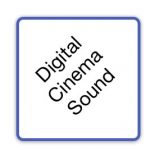
Digital cinema sound is unique from every other commercial distribution format in that the audio signal is not compressed. Audio is delivered to the cinema in full 24-bits per sample, typically 48,000 samples per second. (It is possible to carry sound at 96KHz sampling rate, but this rate rarely, if ever, is used.)
Cinema sound has a rich history of formats, beginning with the commercial availability of monophonic sound-on-film in the 1920s. Stereo-matrix optical sound-on-film was popular in the late 1970’s and throughout the 1980’s. (“Matrix” refers to the phase-encoding of 4 channels of sound into 2.) Not only did this format fill out the screen channels with Left, Center, and Right, but also mono Surround. The format also introduced the “horseshoe” array of surround speakers in the auditorium, surrounding the audience. Bass-enhancement, as it was called, derived a low-frequency signal from the front speaker channels, which drove separate low-frequency speakers. When digital sound was introduced for film in the 1990’s, the surround array was divided to deliver a stereo surround signal, and a discrete subwoofer channel was added to the distribution format. This format remains popular today, known as 5.1 sound. The 5.1 format delivers Left (L), Center (C), Right (R), Left Surround (Ls), Right Surround (Rs), and Low Frequency Effects ( LFE, or subwoofer). The astute reader will note that 5.1 sound has 6 channels of sound. In the nomenclature of multi-channel sound, the “.1” indicates the LFE channel. As a result, when counting channels, 5.1 = 5 + 1 = 6.
7.1 sound is an improvement on 5.1, in that it further divides the surround speaker array into four sections: Left Side Surround (Lss), Right Side Surround (Rss), Left Rear Surround (Lrs), and Right Rear Surround (Rrs). This adds up to 8 channels of sound.
The channel labels L, C, R, Ls, Rs, Lss, Rss, Lrs, Rrs, LFE, and more, are defined in SMPTE ST 428-12 DCDM Common Audio Channels and Soundfield Groups.
In digital cinema, the MainSound Track File defines the carriage of 16 channels of sound. Of course, 16 channels is never enough, and emerging immersive sound formats allow a much more complex array of signals. Since 5.1/7.1 sound only occupies 8 channels, at most, of the available 16, there remain 8 channels of bitstream carriage for other signals that are to be synchronized to the movie. It is in these available sound tracks where Assistive Listening and Narrative audio tracks reside, motion seat data resides, as well as compressed video for assistive sign language.
